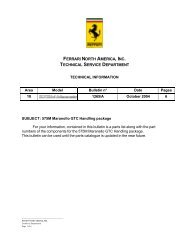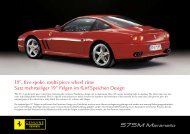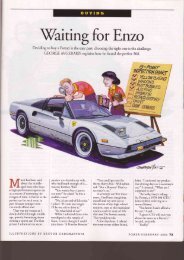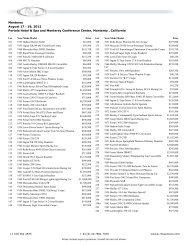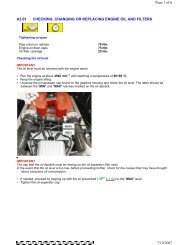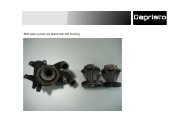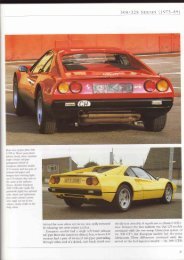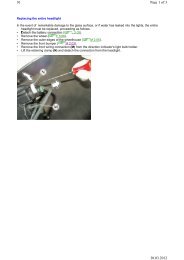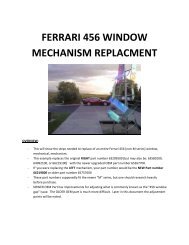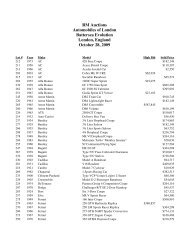Ferrari 308 Buyer's Guide - Ferrari Life
Ferrari 308 Buyer's Guide - Ferrari Life
Ferrari 308 Buyer's Guide - Ferrari Life
Create successful ePaper yourself
Turn your PDF publications into a flip-book with our unique Google optimized e-Paper software.
F e r r a r i F o r u m - w w w . f e r r a r i f o r u m . c o m<br />
Model Information<br />
How successful was the<br />
<strong>308</strong>? Thirty years a�er its launch,<br />
it is still the model that first comes<br />
to mind when most people think<br />
of a <strong>Ferrari</strong>. The launch of the <strong>308</strong><br />
at the Paris Auto Show in 1975<br />
marked a dramatic permanent shi�<br />
in the <strong>Ferrari</strong> philosophy. It was<br />
the first production car to carry<br />
the <strong>Ferrari</strong> badge at launch that<br />
was not powered by a 12 cylinder<br />
engine. Initial press reaction to the<br />
<strong>308</strong> was very positive.<br />
The <strong>308</strong> was the first <strong>Ferrari</strong><br />
road car to sport a fiberglass<br />
body. It is commonly believed<br />
that fiberglass was used in order<br />
to get the new model to market<br />
quickly as the <strong>308</strong> GT4 was not<br />
selling well. It was quicker to make<br />
the moulds for fiberglass than the<br />
dies needed for the metal panels.<br />
The first 712 units were made this<br />
way before the switch back to steel<br />
bodies in 1976. The change to steel<br />
might also have been influenced by<br />
a perceived negative reaction to a<br />
“plastic” <strong>Ferrari</strong> in the US market.<br />
The <strong>308</strong> marked the return,<br />
a�er the brief foray to Bertone for<br />
the <strong>308</strong> GT4, to Pininfarina for the<br />
design. Pininfarina did a masterful<br />
job incorporating elements<br />
of both the Dino 246 and the 512<br />
Berline�a Boxer. The end result<br />
is a design which clearly fits into<br />
the <strong>Ferrari</strong> line both as an evolution<br />
of the Dino 246 and as a junior<br />
stable mate for the Boxers. The<br />
wedge nose is a clear adaptation<br />
from the Boxer whiles the wrap<br />
around rear window, wheel arches,<br />
and recessed air intakes running<br />
along the doors, are clearly evolutions<br />
from the Dino. Overall the<br />
<strong>308</strong> is a wonderful design which<br />
flows smoothly as the eye moves<br />
across the car. With the exception<br />
of minor updating with the<br />
launch of the 328 in 1985, the basic<br />
design remained unchanged for a<br />
remarkable 15 years. By the end<br />
2 <strong>Ferrari</strong> Forum<br />
of the production run in 1985, the<br />
<strong>308</strong> was by far the most successful<br />
<strong>Ferrari</strong> to date with close to 14,000<br />
cars produced. As a reference less<br />
than 2,500 Boxers were produced<br />
in its 10 year production run.<br />
The <strong>308</strong> went through<br />
several major changes during its<br />
long run. These will be covered in<br />
detail in the next section. The most<br />
significant changes were the move<br />
from fiberglass to steel bodies in<br />
1976, the launch of the GTS with a<br />
removable roof panel in 1977, the<br />
adoption of fuel injection in 1980<br />
on the <strong>308</strong> GTBi/GTSi, and the<br />
move from a 2 to a 4 valve engine<br />
with the Qua�rovalvole in 1983.<br />
In general US <strong>308</strong> models can be<br />
identified by their heavy protruding<br />
bumpers, rectangular side<br />
markers, and the exhaust shield.<br />
The basic mechanicals of<br />
the <strong>308</strong> are a mid-engine configuration<br />
using a quad cam 90 degree<br />
V8 si�ing transversally behind the<br />
cabin mated to a 5-speed manual<br />
gearbox. Camsha�s were beltdriven,<br />
and power was taken by a<br />
dry plate clutch mounted on the<br />
flywheel and delivered through<br />
all synchromesh indirect gears. A<br />
front-mounted radiator with twin<br />
fans vented engine cooling air<br />
though the bonnet louvres while<br />
side intakes just rear of the doors<br />
provided for engine and oil-cooler<br />
airflows. For the first five years,<br />
four twin throat Weber carburetors<br />
feed the 3 liter engine. Fuel<br />
injection was adopted in 1980 to<br />
meet ever increasing US emission<br />
standards.<br />
The chassis is welded<br />
tubular steel and this created a<br />
stiff and robust vehicle. The floor<br />
pan and inner wheel arches are<br />
fiberglass. Suspension is independent<br />
unequal length A arms with<br />
tubular shock absorbers and antiroll<br />
bars. Steering was via direct<br />
rack-and-pinion and brakes were<br />
all-wheel disks with power assistance.<br />
The gear change can be stiff<br />
and requires focus to slot properly.<br />
Windows on all <strong>308</strong> are electric<br />
and seats are trimmed in leather,<br />
adjustable fore and a�, with tiltable<br />
back rests and head rests. The<br />
wheel base was 8 inches shorter<br />
than the <strong>308</strong> GT4 and identical<br />
to the Dino 246. Luggage space<br />
was provided in the rear of the<br />
car behind the engine. A zippered<br />
cover protected contents from<br />
the engine. A spare tire was fi�ed<br />
in the front of the car behind the<br />
radiators. The fuel cap is mounted<br />
on the le� rear quarter panel and<br />
feeds twin 37 liter tanks. It is the<br />
last <strong>Ferrari</strong> designed for drivers<br />
under six feet tall.<br />
Model Information<br />
<strong>308</strong> GTB/GTS (1975-1980)<br />
The first <strong>308</strong>’s launched<br />
in 1975 shared the 3 liter engine<br />
with the <strong>308</strong> GT4. It was feed by<br />
four twin throat Weber carburetors<br />
and produced 255 bhp at<br />
7700 rpm. The first 712 cars were<br />
produced with Fiberglass bodies<br />
and weighed in at a svelte 2745 lbs.<br />
European models had dry sump<br />
lubrication with US models being<br />
supplied with wet sump systems.<br />
US models were 200 lbs heavier<br />
and lost 20 bhp to emissions<br />
requirements. As of 1976 steel<br />
bodies were supplied with US cars<br />
with all European models switching<br />
to steel in 1977. The steel<br />
bodies were not rust proofed until<br />
1984. 1977 also saw the introduction<br />
of the GTS with a fiberglass,<br />
vinyl covered, removable roof<br />
panel. The panel was a�ached via<br />
two center catches and stowed behind<br />
the seats. The GTS also had<br />
vertically sla�ed hinged covers on<br />
the rear quarter windows. European<br />
models had a single tail exhaust<br />
pipe while all US cars had a pair.



